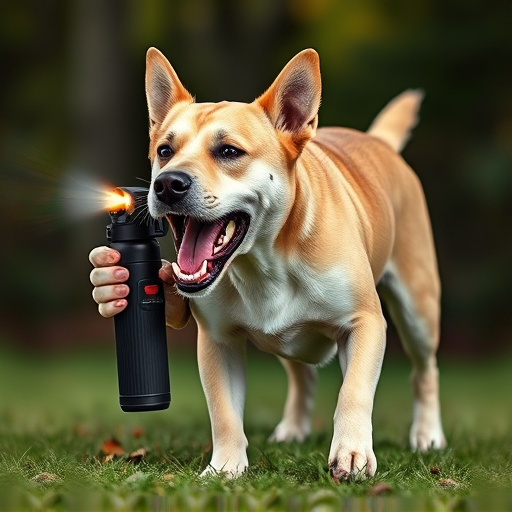Animal control sprays, known as canine deterrents or pepper sprays, utilize capsaicin (Oleoresin Capsaicin – OC) to temporarily incapacitate aggressive dogs and other animals. Professional-strength sprays, with OC percentages ranging from 10% to 25%, offer maximum effectiveness against larger animals while adhering to legal guidelines for civilian use. The higher the OC percentage, the longer-lasting and stronger the immobilizing effects. These sprays are crucial tools for professionals dealing with wild or unrestrained dogs and are also used in crowd control during demonstrations. However, proper training, protective gear, and adherence to local laws (regulating OC percentages) are essential when using these powerful yet controlled solutions.
- Understanding Animal Control Sprays: An Overview
- The Role of Capsaicin: Active Ingredient in Canine Pepper Spray
- OC Percentage: What Does it Indicate?
- Applications and Benefits of Professional-Strength Sprays
- Safety Measures and Legal Considerations for Use
Understanding Animal Control Sprays: An Overview
Animal control sprays, also known as pepper sprays or canine deterrents, are specialized products designed to temporarily incapacitate or discourage aggressive animals, particularly dogs. These sprays contain capsaicin, a compound derived from chili peppers, which irritates the animal’s eyes and respiratory system, leading to a temporary yet effective immobilization. The strength of these sprays is measured in OC (Oleoresin Capsaicin) percentage, indicating the concentration of capsaicin present.
Professional-strength animal control sprays typically have higher OC percentages, ranging from 10% to 20%, ensuring maximum effectiveness against large or particularly aggressive dogs. The OC Percentage in Canine Pepper Spray plays a crucial role in its performance, as a higher concentration offers longer-lasting and stronger immobilizing effects. This feature makes them indispensable tools for professional animal handlers, wildlife managers, and individuals who work in areas frequented by wild or unrestrained dogs.
The Role of Capsaicin: Active Ingredient in Canine Pepper Spray
Capsaicin, the active ingredient in canine pepper spray, plays a crucial role in its effectiveness as an animal control solution. This potent compound is found naturally in chili peppers and is responsible for the burning sensation humans experience when they come into contact with them. In the context of spray, capsaicin creates a powerful irritation to the eyes, nose, and throat of target animals, temporarily disorienting and deterring them.
The OC (Oleoresin Capsaicin) percentage in canine pepper spray is a key factor determining its potency. Higher concentrations of OC ensure more intense stimulation, making it an effective deterrent for aggressive dogs or wild animals. Typically, professional-strength sprays contain OC levels ranging from 10% to 20%, ensuring a robust and reliable animal repellant effect while adhering to legal guidelines for civilian use.
OC Percentage: What Does it Indicate?
The OC (Oleoresin Capsicum) percentage is a crucial indicator of the potency and effectiveness of canine pepper spray. It represents the concentration of capsaicin, the active ingredient responsible for the burning sensation associated with chili peppers. In professional-strength sprays, this percentage can range from 10% to 25%, ensuring a powerful impact when used against aggressive or unruly animals.
When considering OC Percentage in canine pepper spray, it’s essential to match it with the intended use and target animal. Higher concentrations are suitable for larger, more robust species like dogs or wild boars, while lower percentages might be more effective for smaller animals. This measurement is key to ensuring the spray delivers the desired level of deterrence without causing unnecessary harm.
Applications and Benefits of Professional-Strength Sprays
Professional-strength animal control sprays are designed for efficient and effective management of aggressive animals, offering a powerful yet controlled solution for various scenarios. These sprays typically contain a high OC (Oleoresin Capsicum) percentage, often exceeding 10% in canine pepper spray formulations. The OC percentage determines the intensity of the spray’s sting and its ability to incapacitate an animal temporarily.
The applications range from crowd control during demonstrations to protecting individuals and pets from aggressive dogs. Benefits include a fast-acting formula that can subdue an animal within seconds, providing crucial time for escape or assistance. Moreover, these sprays are designed with a wide reach and high visibility, allowing users to maintain a safe distance while neutralizing the threat effectively.
Safety Measures and Legal Considerations for Use
When using professional-strength animal control spray, safety should be the top priority. It’s crucial to understand that canine pepper spray, with its OC (oleoresin capsicum) percentage, can cause significant irritation and even blindness if misused. Always wear protective gear, including gloves, eye protection, and long-sleeved clothing, when handling and deploying the spray. Ensure you are trained in its use and follow manufacturer instructions strictly.
Legally, the use of such spray varies by jurisdiction. Some areas have strict regulations on who can possess and deploy it, while others may permit its use only for specific purposes like livestock protection or wildlife control. It’s essential to check local laws and obtain any necessary permits before purchasing and using animal control spray with high OC percentages. Remember, misuse could lead to serious legal consequences.
Professional-strength animal control sprays, with their high OC (oleoresin capsicum) percentages, offer a powerful yet safe solution for managing and protecting against aggressive or problematic animals. By understanding the active ingredient, capsicum, and the significance of OC levels, users can make informed decisions when choosing an effective spray. These sprays provide various benefits, from deterring wildlife to aiding in the control of domestic animals. However, it’s crucial to prioritize safety and adhere to legal guidelines for responsible use, ensuring these tools remain effective and harmless in the hands of professionals and authorized individuals.
